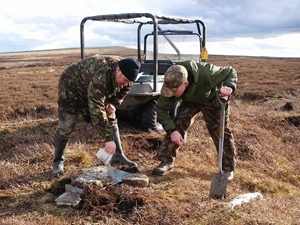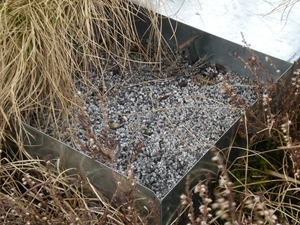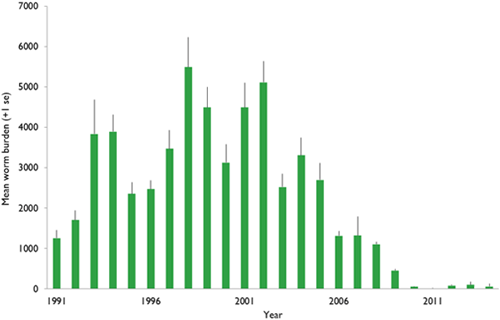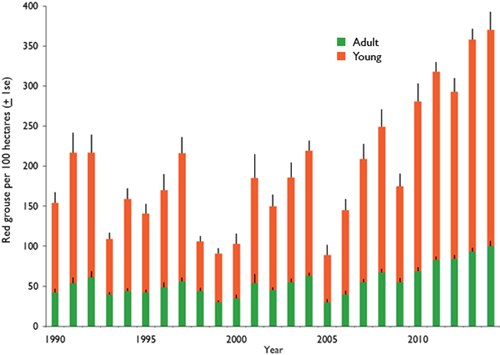
The presence of Trichostrongylus tenuis, a parasitic threadworm which lives in the gut of red grouse, has been known for more than 100 years, often referred to as Strongylosis or the strongyle worm. Over the past 35 years, research by the GWCT has established that the strongyle worm can cause cyclical fluctuations in grouse numbers every 4-5 years. We have attempted to reduce the impact of worms on grouse and to prevent these cycles.
Medicated grit

Medicated grit was developed in the 1980s by the Strathclyde Chemical Company. The original drug used in medicated grit was fenbendazole (part of the benzimidazole group of drugs), sold by Hoechst Animal Health under the trade name of Panacur. The benzimidazole group of drugs are ideal because they are not soluble in water, do not break down in sunlight and work well as split dose drugs. Split dose drugs work by allowing the animal to take in small amounts of the anthelmintic over a period of days, which then accumulates in the body.
Medicated grit is only available under licence, a veterinarian prescription is required to purchase medicated grit from the manufacturers. Evidence of high strongyle burdens in the grouse population will be required by the veterinarian before they can dispense the appropriate prescription.
Original medicated grit
The original medicated grit reduced worm burdens in grouse by an average of 44% and increased grouse productivity by 40%, largely through improving chick survival. Reducing parasites helps to improve body condition in grouse and reduces scent emission, making the birds less vulnerable to mammalian predators when breeding.
To facilitate the legal requirement of withdrawing medication prior to the birds being shot and eaten, the fats used had a “slip point” of 17°C, whereby the fat layer melted in summer and with it went the anthelmintic. By late-summer harvesting, the drug had gone. Because the fat and drug it contained were temperature sensitive, unpredictable spells of mild weather, even in early spring, could result in a rapid loss of medicated grit’s ability to kill worms when it was needed most.
New medicated grit
Very little changed in medicated grit formulation until 2007, when, as a result of these shortfalls, a new product became available involving:
- A change in the drug used from fenbendazole to flubendazole; still part of the benzimidazole family of drugs, but now licensed for game birds.
- Transformation from a “fat” with a temperature slip point to a stable non-slip “fat” with greater persistency.
- To comply with the legal requirement to withdraw the drug 28 days before grouse were harvested and consumed, the new medicated grit was placed in a box with a lid to prevent access by grouse.
Use of improved medicated grit appears to have almost stopped grouse cycles with strongyle worm levels being at all-time lows (see Figure 1) and with an almost doubling of grouse densities (see Figure 2) resulting in the record bags we are currently experiencing. This increased efficiency of medicated grit and increased grouse densities can lead to new problems:
- Resistance to the current anthelmintic through overuse.
- Emergence of new diseases.
Figure 1: Average annual worm burden in autumn-shot adult grouse
from between 8-18 sites across northern England, 1991-2014.
Figure 2: Average density of young and adult red grouse in July
from 25 sites across northern England, 1990-2014.

History of control
We have helped develop two methods of providing grouse with an anthelmintic (worming drug) to kill worms:
- Catching grouse at night and treating them with a levamisole hydrochloride oral drench anthelmintic (trade name Nilverm). This, however, proved labour-intensive and unsuitable where terrain made night access difficult and dangerous.
- An indirect method, involving a grouse’s requirement for quartz grit in their gizzard to aid the digestion of its fibrous diet of heather shoots, which make up 80% of the diet. Grit can occur naturally on moors but is also provided by gamekeepers. Grouse consume approximately 35g of grit per month. For reducing worms, quartz grit is used that has been treated with a thin covering of fat into which an anthelmintic drug is impregnated. This is known as ‘medicated grit’.
